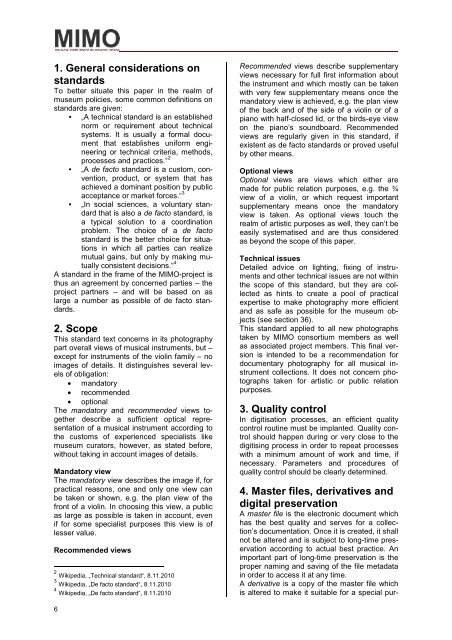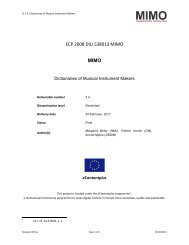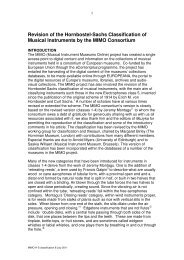MIMO Digitisation Standard
MIMO Digitisation Standard
MIMO Digitisation Standard
- No tags were found...
You also want an ePaper? Increase the reach of your titles
YUMPU automatically turns print PDFs into web optimized ePapers that Google loves.
1. General considerations onstandardsTo better situate this paper in the realm ofmuseum policies, some common definitions onstandards are given:• „A technical standard is an establishednorm or requirement about technicalsystems. It is usually a formal documentthat establishes uniform engineeringor technical criteria, methods,processes and practices.“ 2• „A de facto standard is a custom, convention,product, or system that hasachieved a dominant position by publicacceptance or market forces.“ 3• „In social sciences, a voluntary standardthat is also a de facto standard, isa typical solution to a coordinationproblem. The choice of a de factostandard is the better choice for situationsin which all parties can realizemutual gains, but only by making mutuallyconsistent decisions.“ 4A standard in the frame of the <strong>MIMO</strong>-project isthus an agreement by concerned parties – theproject partners – and will be based on aslarge a number as possible of de facto standards.Recommended views describe supplementaryviews necessary for full first information aboutthe instrument and which mostly can be takenwith very few supplementary means once themandatory view is achieved, e.g. the plan viewof the back and of the side of a violin or of apiano with half-closed lid, or the birds-eye viewon the piano’s soundboard. Recommendedviews are regularly given in this standard, ifexistent as de facto standards or proved usefulby other means.Optional viewsOptional views are views which either aremade for public relation purposes, e.g. the ¾view of a violin, or which request importantsupplementary means once the mandatoryview is taken. As optional views touch therealm of artistic purposes as well, they can’t beeasily systematised and are thus consideredas beyond the scope of this paper.Technical issuesDetailed advice on lighting, fixing of instrumentsand other technical issues are not withinthe scope of this standard, but they are collectedas hints to create a pool of practicalexpertise to make photography more efficientand as safe as possible for the museum objects(see section 36).2. ScopeThis standard applied to all new photographsThis standard text concerns in its photography taken by <strong>MIMO</strong> consortium members as wellpart overall views of musical instruments, but ‒ as associated project members. This final versionis intended to be a recommendation forexcept for instruments of the violin family ‒ noimages of details. It distinguishes several levelsof obligation:strument collections. It does not concern pho-documentary photography for all musical in-• mandatorytographs taken for artistic or public relation• recommendedpurposes.• optionalThe mandatory and recommended views togetherdescribe a sufficient optical repre-In digitisation processes, an efficient quality3. Quality controlsentation of a musical instrument according to control routine must be implanted. Quality controlshould happen during or very close to thethe customs of experienced specialists likemuseum curators, however, as stated before, digitising process in order to repeat processeswithout taking in account images of details.with a minimum amount of work and time, ifnecessary. Parameters and procedures ofMandatory viewquality control should be clearly determined.The mandatory view describes the image if, forpractical reasons, one and only one view can 4. Master files, derivatives andbe taken or shown, e.g. the plan view of thefront of a violin. In choosing this view, a publicas large as possible is taken in account, evenif for some specialist purposes this view is oflesser value.Recommended views2 Wikipedia, „Technical standard“, 8.11.20103 Wikipedia, „De facto standard“, 8.11.20104 Wikipedia, „De facto standard“, 8.11.20106digital preservationA master file is the electronic document whichhas the best quality and serves for a collection’sdocumentation. Once it is created, it shallnot be altered and is subject to long-time preservationaccording to actual best practice. Animportant part of long-time preservation is theproper naming and saving of the file metadatain order to access it at any time.A derivative is a copy of the master file whichis altered to make it suitable for a special pur-





